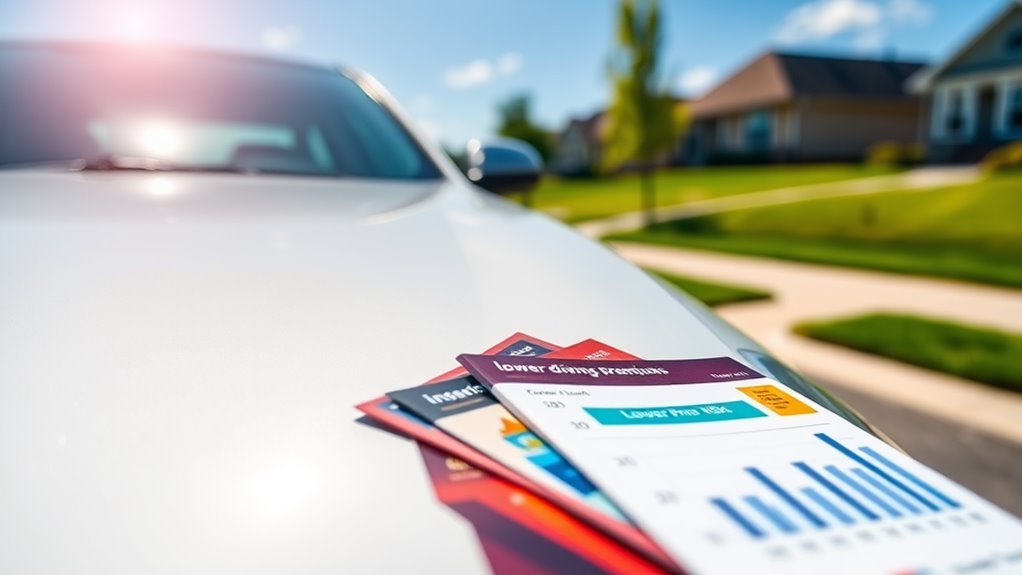Maintaining a clean driving record is vital for lowering your insurance premiums. Insurers view safe drivers as lower risk, which opens the door to various discounts and benefits. Understanding how traffic violations can drastically impact your rates is essential. From telematics programs to defensive driving courses, there are several strategies to maximize your savings. Let's explore the ten best ways a clean record can make a significant difference in your insurance costs.
Key Takeaways
- Clean driving records classify drivers as preferred customers, leading to significantly lower insurance premiums.
- Insurers offer discounts for safe driving habits, with savings ranging from 5% to 30% for maintaining a clean record.
- Traffic violations increase risk assessments, making clean records essential for minimizing insurance costs.
- Enrollment in telematics programs can further reduce premiums by monitoring safe driving habits and offering additional discounts.
- Regularly reviewing driving habits and completing defensive driving courses can maintain a clean record and enhance premium savings.
Clean Driving Records Indicate Lower Risk to Insurers

A clean driving record serves as a crucial indicator of an individual's risk profile to insurers. When you maintain a spotless record, insurers view you as a responsible driver, which translates to lower premiums. Traffic violations and accidents can greatly increase your risk assessment, leading to higher costs. Insurers utilize complex algorithms that prioritize driving history, so having a clean record often categorizes you as a preferred customer. This classification typically results in cheaper insurance rates. In addition, improved driving habits can further enhance your standing, reducing risk and costs over time. The point system shows that even minor infractions can accumulate points, impacting your premiums for years. Additionally, Michigan's unique no-fault insurance laws may further benefit those with clean driving records. Therefore, keeping your driving record clean is essential for minimizing insurance expenses.
Discounts for Safe Drivers: A Reward for Clean Records
Maintaining a clean driving record not only reflects responsible behavior but also opens the door to various discounts from insurance providers.
Safe driving discounts come in multiple forms, including accident-free, defensive driving course, and telematics-based discounts. To qualify, you typically need a clean record for three to five years, free from at-fault accidents and major violations.
Savings can range from 5% to 30%, depending on the insurer. Some discounts are automatically applied at policy renewal if you meet the criteria.
Companies like GEICO and Liberty Mutual offer significant savings for safe driving habits, while completing a defensive driving course can lead to further reductions.
Reviewing your policy and consulting your agent can maximize these opportunities.
The Role of Traffic Violations in Premium Increases
While safe driving discounts reward responsible behavior, traffic violations can lead to significant increases in your insurance premiums. Offenses like speeding, reckless driving, and DUIs can hike your rates substantially, often by 20-95%, depending on severity.
Traffic violations can drastically increase your premiums, with offenses potentially raising rates by 20-95%.
Minor infractions may have a lesser impact, but they still contribute to your overall risk profile. Typically, violations affect your rates for 3-5 years, with serious offenses lingering even longer.
State laws also play a role in how these violations are recorded and penalized. To mitigate the impact, consider attending traffic school or completing defensive driving courses.
Maintaining a clean driving record is key to minimizing insurance costs and ensuring you don't face excessive rate increases.
Telematics Programs: Additional Savings for Safe Driving

Telematics programs offer drivers an innovative way to potentially save on insurance premiums by closely monitoring driving habits. By utilizing devices or smartphone apps, these programs collect data on mileage, speed, and driving behaviors, allowing insurers to assess your driving style accurately.
You can earn personalized feedback, which helps improve your skills and potentially lower your premiums. Enrollment discounts are often available, and safe driving can lead to significant savings—up to 40% in some cases.
Additionally, low-mileage drivers can benefit from pay-per-mile insurance, ensuring you only pay for the miles you drive. Overall, telematics programs provide a tailored approach to insurance, rewarding safe practices while promoting better driving behavior.
Accident Forgiveness Programs for Clean Record Holders
Accident forgiveness programs provide a valuable safety net for clean record holders, allowing them to protect their premiums against increases following an at-fault accident.
Typically, these programs require you to maintain a clean driving record for three to five years, depending on your insurer. Various carriers have different criteria; some may ask for five years of policy loyalty or a minimum of six years of driving experience.
By opting for accident forgiveness, you can avoid premium hikes after your first at-fault incident, providing financial security and peace of mind.
However, once utilized, the benefit often can't be reapplied until your record is clean for a specified period, usually six years.
Weigh the additional cost against potential savings carefully.
The Importance of Avoiding At-Fault Accidents
Maintaining a clean driving record isn't just about saving on insurance premiums; it greatly impacts your overall driving experience and financial security.
At-fault accidents can lead to significant premium increases, as insurers view you as a higher risk. This perception not only raises your rates but can also affect your credibility during claims, complicating settlements.
Furthermore, accidents can linger on your record for years, perpetuating higher costs. By avoiding at-fault incidents, you minimize liability and maintain stable premiums.
A clean record reflects safe driving behavior, building trust with insurers and simplifying claim processes.
Prioritizing safety not only protects you on the road but also safeguards your financial future, making it essential to focus on accident prevention.
Defensive Driving Courses: An Opportunity for Discounts

While many drivers focus solely on avoiding accidents, enrolling in a defensive driving course can be a proactive step toward both enhancing your skills and reducing insurance costs.
These courses, which can often be completed online or in person, teach valuable techniques for accident avoidance and improved safety. By finishing an approved course, you could earn discounts on your premiums ranging from 10% to 20% for several years.
Some states even require insurers to offer these discounts. Additionally, completing the course may help you reduce points on your license, preventing further rate increases.
Remember to check your state's regulations and submit your completion certificate to your insurer to access these potential savings.
The Impact of Annual Mileage on Insurance Premiums
As your annual mileage increases, so does your risk profile in the eyes of insurers, which can considerably impact your insurance premiums.
Driving more than 20,000 miles a year often leads to significant premium hikes, as insurers associate higher mileage with a greater likelihood of accidents. For instance, if you drive 15,000 miles annually, you might see your premiums rise by 25% compared to lower mileage drivers.
Insurers categorize mileage into low, average, and high brackets, with low-mileage drivers frequently qualifying for discounts. Tracking your mileage accurately can help you secure these savings, especially if you drive fewer than 5,000 miles, where discounts can reach up to 36%.
Regularly reviewing your driving habits is essential for optimizing your insurance costs.
Comparing Insurance Rates to Maximize Savings
How can you effectively compare insurance rates to maximize your savings? Start by understanding that rates for identical coverage can vary greatly between providers.
Different policies offer varying coverage types and deductibles, influencing your overall costs. Consider bundling auto and home insurance for additional discounts.
Utilize independent agencies to access multi-provider comparisons, tailored coverage, and expert advice. Online platforms like Matic allow you to compare quotes quickly, often resulting in considerable savings—averaging $826 for their users.
Remember to look at customer reviews to assess insurers' reliability. By regularly checking rates and adjusting your coverage, you can guarantee you're getting the best deal without sacrificing necessary protection.
The Influence of ZIP Codes on Insurance Costs for Safe Drivers
Insurance rates can considerably impact your overall driving costs, and one of the most influential factors is your ZIP code. Urban areas often lead to higher premiums due to increased accident rates and population density.
Even if you're a safe driver, living in a risky ZIP code can result in elevated insurance costs. Factors like crime rates, weather conditions, and traffic congestion all contribute to this risk profile.
Living in a high-risk ZIP code can increase insurance costs, regardless of your safe driving record.
Some states, like California and Michigan, limit how ZIP codes affect rates, while others don't. To mitigate costs, consider installing anti-theft devices or exploring discounts for safety features.
Understanding your ZIP code's influence can help you make informed decisions and potentially lower your premiums.
Conclusion
In summary, maintaining a clean driving record not only reflects your commitment to safety but also reveals significant savings on insurance premiums. It's interesting how a single traffic violation can lead to a steep increase, while safe driving can ironically lead to better rates and discounts. By understanding these dynamics, you can strategically navigate your insurance options, ensuring you maximize your savings while minimizing risk—an alignment that benefits both you and your insurer.











 Getting the right auto insurance policy can be a challenge. It’s important to make sure you have adequate protection for both you and your vehicle. Whether you’re a first-time buyer or looking to switch, understanding the basics and taking some time to shop around can help you find the best option for your needs. Here are some tips for finding the right auto insurance policy for you:
Getting the right auto insurance policy can be a challenge. It’s important to make sure you have adequate protection for both you and your vehicle. Whether you’re a first-time buyer or looking to switch, understanding the basics and taking some time to shop around can help you find the best option for your needs. Here are some tips for finding the right auto insurance policy for you: Firstly, it is important to determine your coverage needs. Knowing fully what is included in your policy and what you are covered and not covered for is essential. Consider whether you need extra coverage such as advanced liability, towing, rentals, and more. Discuss these options with your insurance provider and tailor your policy to fit your needs.
Firstly, it is important to determine your coverage needs. Knowing fully what is included in your policy and what you are covered and not covered for is essential. Consider whether you need extra coverage such as advanced liability, towing, rentals, and more. Discuss these options with your insurance provider and tailor your policy to fit your needs.


